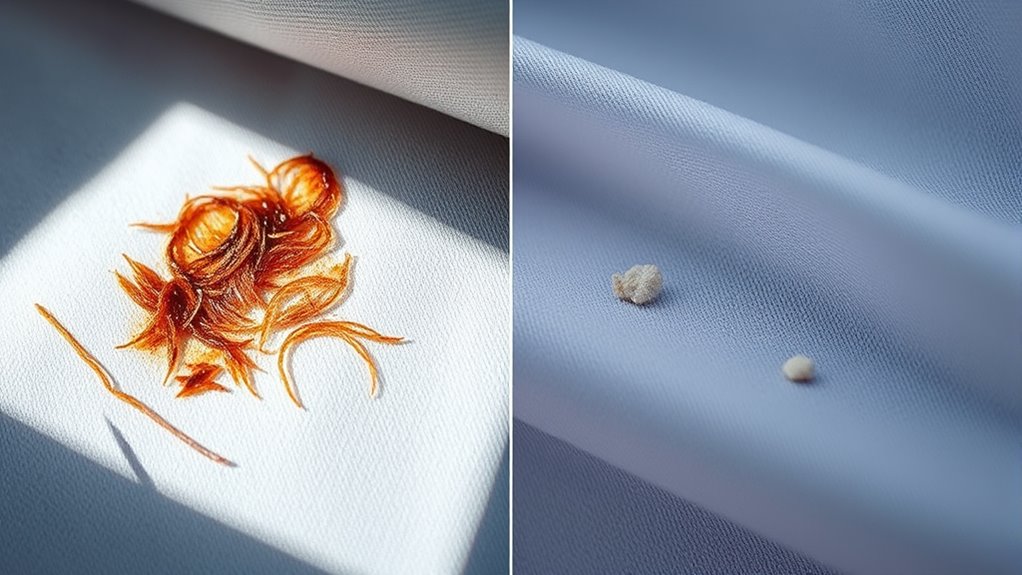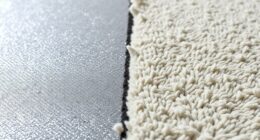Oxy cleaners use active oxygen to break down organic molecules, making them effective on fresh or lightly soiled protein stains, especially with warm water. Enzyme cleaners employ biological catalysts to target specific proteins, breaking them into washable fragments for thorough removal. While oxy cleaners act broadly and quickly, enzymes excel on stubborn, older stains that are deeply embedded. To learn more about choosing the best option for your stains, keep exploring the differences.
Key Takeaways
- Enzyme cleaners specifically target protein molecules, breaking them down into washable fragments, while oxy cleaners oxidize organic compounds generally.
- Enzyme cleaners are more effective on older, embedded protein stains, whereas oxy cleaners work best on fresh or lightly soiled stains.
- Oxy cleaners rely on chemical oxidation and are less substrate-specific, making them broader but sometimes less effective on stubborn protein stains.
- Enzyme cleaners operate optimally in warm water and require proper timing for maximum stain removal.
- Combining both cleaners can enhance stain removal, but choosing depends on stain age, fabric, and specific stain type.
Understanding Protein Stains: What Are They?

Have you ever wondered what exactly makes a stain a protein stain? Protein stains usually have a distinctive stain color, often yellow, brown, or reddish, because of the organic substances they contain. These stains come from substances like blood, sweat, dairy, or egg, which are rich in proteins. Understanding fabric sensitivity is vital because some fabrics, like silk or wool, are more delicate and can be damaged by harsh cleaners. Protein stains tend to set if exposed to heat or prolonged drying, making them more difficult to remove later. Recognizing these stains early and knowing their color and fabric sensitivity helps you choose the right cleaning approach, preventing permanent damage and ensuring effective stain removal. Properly maintaining your air purifier can also help reduce airborne allergens that may contribute to skin sensitivities or irritations caused by residues or pollutants. Additionally, utilizing enzyme cleaners specifically formulated for protein stains can significantly improve removal effectiveness, especially on delicate fabrics. Awareness of stain chemistry can guide you in selecting the most suitable cleaning methods, ensuring better results and preserving your fabrics over time. Being aware of regional resources and local experts can also provide additional guidance if you encounter stubborn stains or fabric concerns.
How Oxy Cleaners Work on Protein Residues
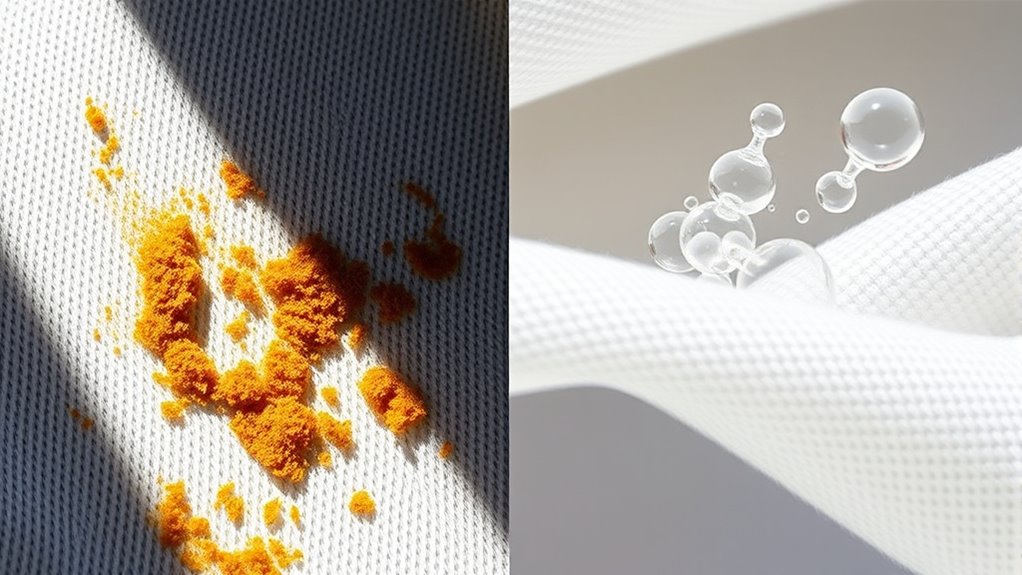
Oxy cleaners work effectively on protein residues by releasing active oxygen molecules that break down organic compounds. This process enhances stain removal by oxidizing the proteins embedded in fabrics, making them easier to lift away. In terms of cleaning chemistry, oxy cleaners use oxygen-based compounds such as hydrogen peroxide or sodium percarbonate to generate these reactive oxygen species. When applied, these molecules attack the organic molecules in stains, disrupting their structure and loosening them from fibers. Unlike enzymatic cleaners, oxy cleaners don’t require specific enzymes and work well on a variety of protein stains, including blood, sweat, and food. This broad-spectrum activity makes oxy cleaners a versatile option for tackling protein residues, especially in situations where quick, effective stain removal is needed. Additionally, the effectiveness of oxy cleaners can be influenced by proper application techniques, ensuring maximum contact with stains for optimal results. Proper stain pretreatment can further enhance their effectiveness, especially on stubborn residues.
The Mechanism Behind Enzyme Cleaners
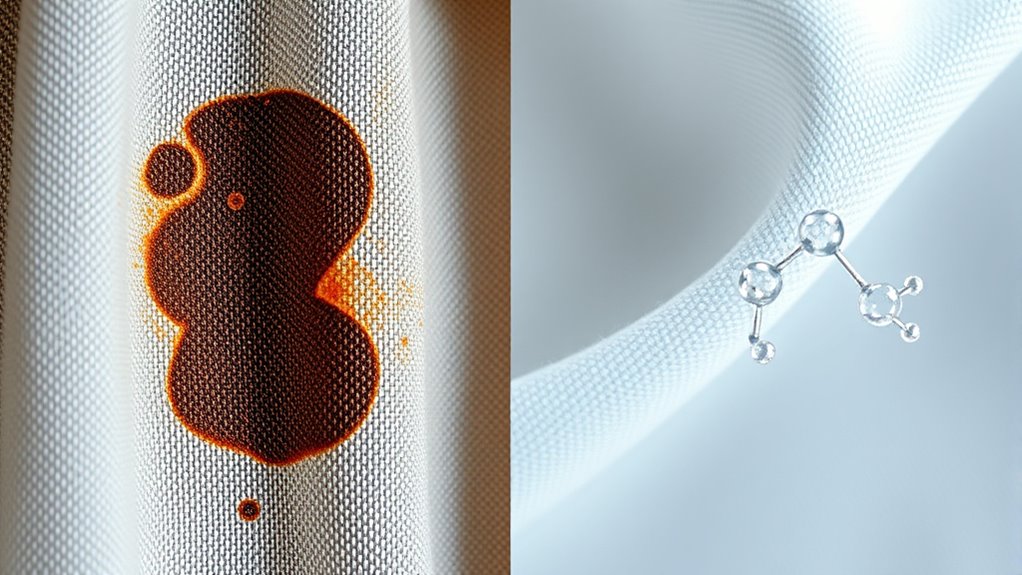
Enzyme cleaners target protein stains by employing specific biological catalysts called enzymes, which speed up the breakdown of organic molecules. These enzymes facilitate biochemical reactions by binding to target proteins with high enzyme specificity, ensuring efficient stain removal. Each enzyme is designed to recognize a particular substrate, like keratin or casein, and catalyze its decomposition into smaller, washable fragments. This targeted action allows enzymes to work effectively in breaking down stubborn protein residues. Utilizing testing tools and following best practices in cleaning processes can further optimize stain removal efficiency and effectiveness. Incorporating the right cleaning techniques can also enhance the overall stain removal process. Additionally, understanding the enzyme specificity helps in selecting the most suitable enzyme cleaner for different types of protein stains.
Effectiveness of Oxy Cleaners on Different Types of Protein Stains
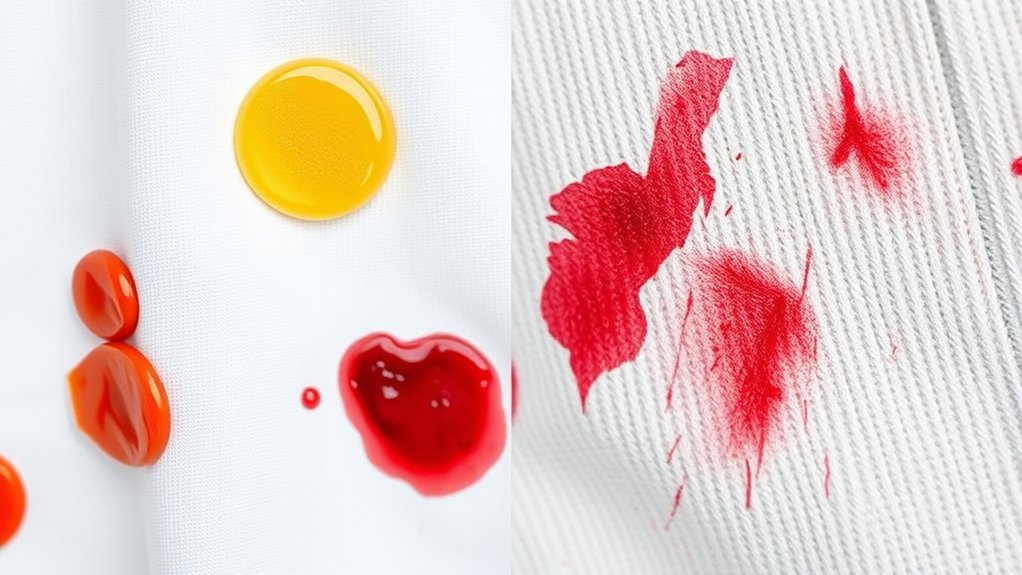
While enzyme cleaners excel at breaking down specific protein stains through targeted biochemical reactions, oxy cleaners rely on oxidation to remove various organic residues. The effectiveness of oxy cleaners depends on the molecular structure of the stain, particularly how easily oxidation can break down complex proteins like blood, sweat, or food residues. Oxy cleaners are generally versatile, working well on fresh or lightly soiled stains, but their effectiveness diminishes with older or heavily embedded stains. Regular cleaning frequency helps maintain stain removal efficiency, as repeated treatments can gradually weaken protein bonds. Additionally, understanding the chemical composition of stains can help determine whether oxy cleaners or enzyme cleaners will be more effective. However, oxy cleaners may struggle with certain stain types that have a tightly bound molecular structure, making them less reliable than enzyme cleaners for some protein stains. Your cleaning routine should consider stain type and age for ideal results.
How Enzyme Cleaners Break Down Organic Matter
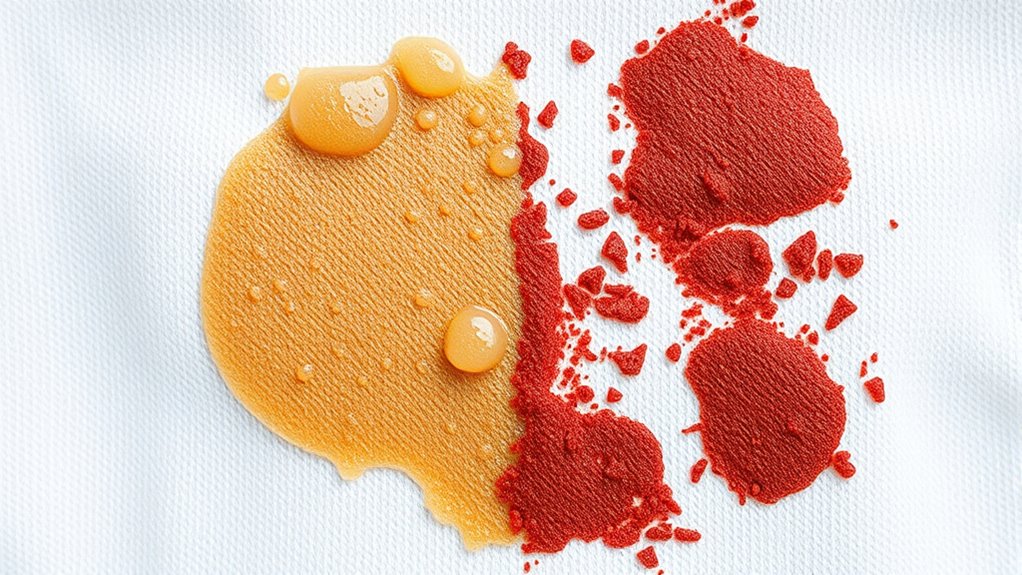
Enzyme cleaners work by harnessing the power of proteins called enzymes to break down organic stains at a molecular level. They facilitate biological breakdown, attacking protein-based residues like blood, sweat, and food. Enzymes act as catalysts, speeding up the process of stain removal without harsh chemicals. They target specific organic compounds, breaking them into smaller, water-soluble molecules that can be easily rinsed away. This precision makes enzyme cleaners highly effective on protein stains. Here’s a breakdown of common enzymes used:
| Enzyme Type | Targeted Organic Matter |
|---|---|
| Protease | Proteins like blood and food |
| Lipase | Fats and oils |
| Amylase | Starches |
| Cellulase | Plant fibers and cellulose |
This biological breakdown ensures thorough stain removal while being gentle on fabrics. Additionally, enzyme cleaners are environmentally friendly, making them a sustainable choice for household cleaning. They are also known for biodegradability, which further supports their eco-friendly profile.
Comparing Cleaning Power: Oxy vs. Enzyme on Protein Stains
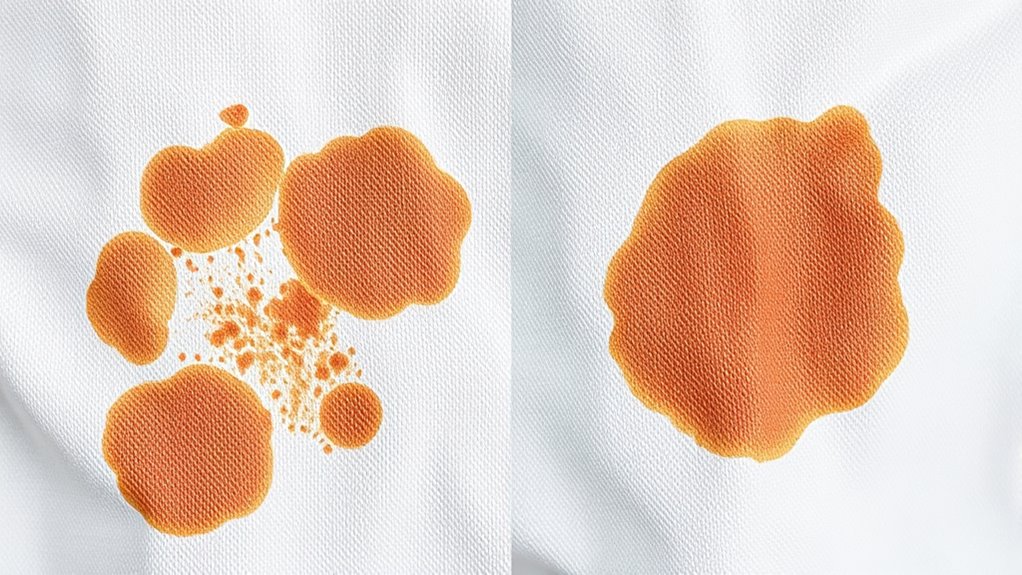
When it comes to tackling protein stains, both oxygen-based cleaners and enzyme-based solutions have their strengths, but their effectiveness depends on the type and severity of the stain. Oxygen cleaners work by releasing reactive oxygen molecules that break down organic material, making them effective on heavily soiled fabrics. Enzymes, on the other hand, target specific proteins, breaking them into smaller, easier-to-remove pieces. Water temperature plays a vital role: enzymes generally perform better in warm water, while oxygen cleaners can be effective across a broader temperature range. Using fabric softeners during the rinse cycle won’t impact their cleaning power but can help maintain fabric softness. Ultimately, your choice depends on the stain’s severity and fabric care instructions.
Practical Tips for Using Oxy and Enzyme Cleaners
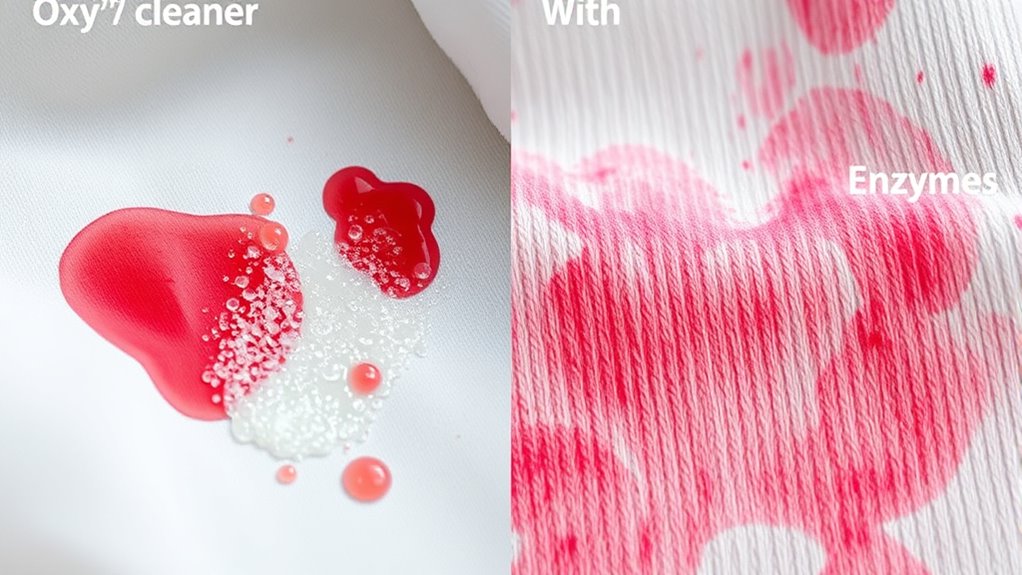
To get the best results, you need to apply oxy and enzyme cleaners correctly and at the right time. Proper application techniques guarantee the stains break down effectively, while timing can prevent set-in marks. Follow these tips to maximize your cleaning efforts and keep your fabrics looking fresh. Additionally, understanding tuning techniques can help you choose the most effective products for your specific stain removal needs. Incorporating AI-powered analytics can further optimize your cleaning routine by identifying the most suitable products based on stain type and fabric. Recognizing color accuracy in stains can also ensure you select the right cleaner for different fabric types and stain colors. Utilizing professional voiceover techniques when explaining these tips can make your instructions more engaging and easier to follow.
Application Techniques
Applying oxy and enzyme cleaners correctly can make a significant difference in how effectively they remove protein stains. Start by testing a small area first to avoid damaging delicate fabrics. For best results, apply enzyme cleaners directly to stained areas, avoiding fabric softeners and scent boosters that can interfere with enzyme activity. Enzyme cleaners excel when left to sit longer, allowing the enzymes to break down proteins more thoroughly. Oxy cleaners work well when pre-soaking or applying as a pretreatment, while enzyme cleaners excel when left to sit longer. Use the table below to visualize application differences:
| Technique | Best for |
|---|---|
| Direct application | Enzyme cleaners on fresh stains |
| Pre-soaking | Oxy cleaners for stubborn or set-in stains |
| Avoid fabric softeners | To prevent enzyme inhibition |
| Use warm water | Enhances cleaning effectiveness |
| Rinse thoroughly | Removes residual cleaner and stains |
Additionally, understanding the types of stains and their compositions can help select the most effective cleaner for protein stains and achieve optimal cleaning results. Proper application techniques can also prevent residue buildup that might diminish cleaning efficiency over time.
Stain Treatment Timing
Timing is crucial when treating protein stains with oxy and enzyme cleaners to guarantee ideal removal. Follow your stain removal schedules closely, applying the cleaner as soon as possible after the stain occurs. Fresh stains respond better, and waiting too long can make removal more difficult. Check the cleaning product shelf life; expired oxy or enzyme cleaners may lose potency, reducing effectiveness. For best results, use fresh products within their recommended shelf life, and avoid letting stains dry out before treatment. If you’re unsure about timing, test a small area first. Prompt action maximizes the cleaner’s effectiveness, preventing the stain from setting deeper into the fabric. Proper timing ensures you get the most out of your stain removal efforts. Additionally, understanding the application techniques of oxy and enzyme cleaners can further improve their efficacy. Being aware of headphone compatibility can also help prevent future stains caused by improper device use around liquids. Maintaining proper storage conditions can also prolong the shelf life of your cleaning products, ensuring they work effectively when needed. Using the right cleaning tools and methods aligns with effective stain removal principles and can significantly enhance your results.
Factors to Consider When Choosing the Right Cleaner

Choosing the right cleaner for protein stains depends on several key factors that can influence its effectiveness. First, consider how chemical reactions work—enzymes break down proteins, while oxygen-based cleaners oxidize stains. Understanding these mechanisms helps you pick the best option. Don’t fall for stain removal myths that suggest one cleaner is always superior; instead, assess the stain’s age, type, and fabric. For delicate fabrics, enzyme cleaners might be gentler, whereas oxygen cleaners can be more effective on older stains. Also, think about safety and environmental impact. By evaluating these factors, you guarantee your chosen cleaner targets stains efficiently without damaging your clothes or wasting resources. Additionally, knowing the GMC tuning techniques can help you understand how specialized formulations work better on specific types of stains. Ultimately, choosing wisely depends on understanding how each cleaner interacts with stains and fabrics.
Frequently Asked Questions
Are Enzyme Cleaners Safe for All Fabrics?
You might wonder if enzyme cleaners are safe for all fabrics. Generally, they work well on natural fibers like cotton and wool, but fabric compatibility varies. Always check the label before use, especially if you have allergy concerns, as some enzymes can cause skin irritation. Test a small area first to prevent damage, and follow manufacturer instructions to guarantee safe and effective cleaning.
Can Oxy Cleaners Remove Set-In Protein Stains?
Oxy cleaners can help with stain removal, but their cleaning effectiveness on set-in protein stains varies. They work by releasing oxygen to lift dirt and stains, which can loosen protein-based residues. However, for deeply embedded or dried-in protein stains, combining oxy cleaners with pre-treatment or soaking may improve results. Keep in mind that patience and proper application are key to achieving the best cleaning outcomes.
How Long Should Enzyme Cleaners Sit Before Washing?
Think of enzyme cleaners as your stain’s best friend, patiently working behind the scenes. You should let them sit for about 15 to 30 minutes, giving the enzymes time to break down proteins. This stain pre-treatment boosts cleaning effectiveness, especially if you plan to wash the item later. For best results, don’t forget to follow the recommended cleaning frequency and always check the fabric care label before washing.
Do Oxy Cleaners Have Any Scent After Use?
After using oxy cleaners, you might notice a fresh scent right after cleaning, but it often doesn’t last long. Some oxy cleaners leave a lingering odor that fades over time, especially once you air out the area. If you prefer a long-lasting fresh scent, consider adding a fragrance booster or using a scented fabric softener. This way, your space remains smelling clean and fresh beyond the initial cleaning.
Are Enzyme Cleaners Effective on Protein Stains in Cold Water?
You might wonder if enzyme cleaners work on protein stains in cold water. The good news is, enzyme effectiveness isn’t hindered by low temperatures, so these cleaners can break down protein stains like blood or sweat effectively even when used cold. Just guarantee you follow the instructions for peak results, and you’ll find enzymes are a reliable choice for tackling protein stains without needing hot water.
Conclusion
Ultimately, choosing between oxy and enzyme cleaners depends on understanding your unique needs. While both have their strengths, sometimes a gentle approach can reveal surprising results. Trust your instincts, and remember that patience often yields the most graceful outcomes. By selecting the right method, you’re guiding your home toward harmony and freshness—letting the subtle art of cleaning restore balance and peace to your space.
